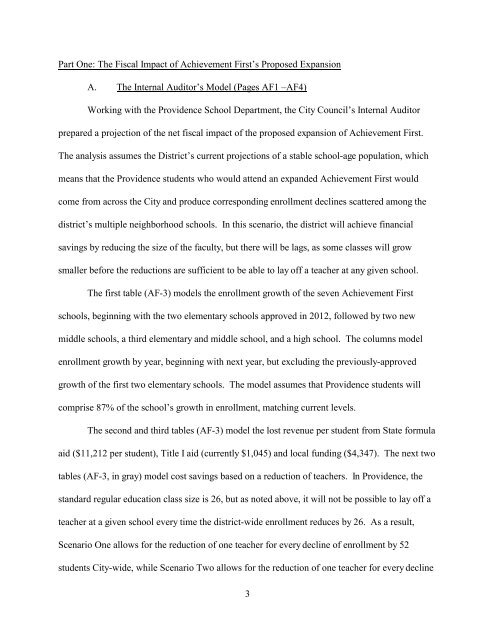11-30-Electronic-Cover-letter-and-Report
11-30-Electronic-Cover-letter-and-Report
11-30-Electronic-Cover-letter-and-Report
You also want an ePaper? Increase the reach of your titles
YUMPU automatically turns print PDFs into web optimized ePapers that Google loves.
Part One: The Fiscal Impact of Achievement Firsts Proposed Expansion<br />
A. The Internal Auditors Model (Pages AF1 AF4)<br />
Working with the Providence School Department, the City Councils Internal Auditor<br />
prepared a projection of the net fiscal impact of the proposed expansion of Achievement First.<br />
The analysis assumes the Districts current projections of a stable school-age population, which<br />
means that the Providence students who would attend an exp<strong>and</strong>ed Achievement First would<br />
come from across the City <strong>and</strong> produce corresponding enrollment declines scattered among the<br />
districts multiple neighborhood schools. In this scenario, the district will achieve financial<br />
savings by reducing the size of the faculty, but there will be lags, as some classes will grow<br />
smaller before the reductions are sufficient to be able to lay off a teacher at any given school.<br />
The first table (AF-3) models the enrollment growth of the seven Achievement First<br />
schools, beginning with the two elementary schools approved in 2012, followed by two new<br />
middle schools, a third elementary <strong>and</strong> middle school, <strong>and</strong> a high school. The columns model<br />
enrollment growth by year, beginning with next year, but excluding the previously-approved<br />
growth of the first two elementary schools. The model assumes that Providence students will<br />
comprise 87% of the schools growth in enrollment, matching current levels.<br />
The second <strong>and</strong> third tables (AF-3) model the lost revenue per student from State formula<br />
aid ($<strong>11</strong>,212 per student), Title I aid (currently $1,045) <strong>and</strong> local funding ($4,347). The next two<br />
tables (AF-3, in gray) model cost savings based on a reduction of teachers. In Providence, the<br />
st<strong>and</strong>ard regular education class size is 26, but as noted above, it will not be possible to lay off a<br />
teacher at a given school every time the district-wide enrollment reduces by 26. As a result,<br />
Scenario One allows for the reduction of one teacher for every decline of enrollment by 52<br />
students City-wide, while Scenario Two allows for the reduction of one teacher for every decline<br />
3


